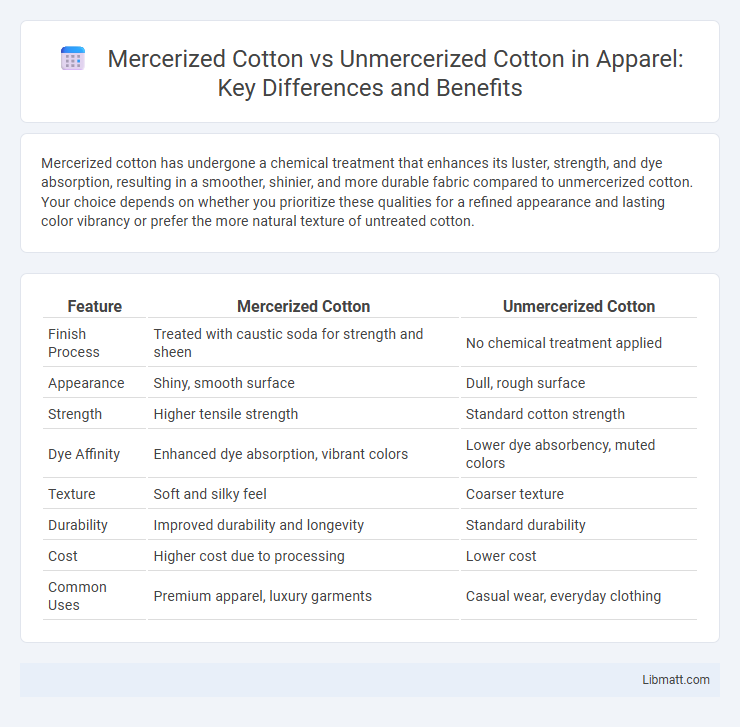Mercerized cotton has undergone a chemical treatment that enhances its luster, strength, and dye absorption, resulting in a smoother, shinier, and more durable fabric compared to unmercerized cotton. Your choice depends on whether you prioritize these qualities for a refined appearance and lasting color vibrancy or prefer the more natural texture of untreated cotton.
Table of Comparison
| Feature | Mercerized Cotton | Unmercerized Cotton |
|---|---|---|
| Finish Process | Treated with caustic soda for strength and sheen | No chemical treatment applied |
| Appearance | Shiny, smooth surface | Dull, rough surface |
| Strength | Higher tensile strength | Standard cotton strength |
| Dye Affinity | Enhanced dye absorption, vibrant colors | Lower dye absorbency, muted colors |
| Texture | Soft and silky feel | Coarser texture |
| Durability | Improved durability and longevity | Standard durability |
| Cost | Higher cost due to processing | Lower cost |
| Common Uses | Premium apparel, luxury garments | Casual wear, everyday clothing |
Introduction: Understanding Mercerized and Unmercerized Cotton
Mercerized cotton undergoes a chemical treatment with caustic soda, enhancing its strength, luster, and dye affinity compared to unmercerized cotton. Unmercerized cotton retains its natural matte finish and softness but lacks the enhanced durability and vibrant color options found in mercerized cotton. The mercerization process increases fiber smoothness, making mercerized cotton ideal for high-quality textiles and premium garments.
What is Mercerized Cotton?
Mercerized cotton is treated with a caustic soda solution that strengthens the fiber, increases its luster, and improves dye absorption, resulting in a smoother and more vibrant fabric. This chemical process causes the cotton fibers to swell, enhancing their tensile strength and making the fabric more resistant to shrinkage and wear. Unlike unmercerized cotton, mercerized cotton offers superior sheen, durability, and color retention, making it a preferred choice for high-quality textiles and apparel.
What is Unmercerized Cotton?
Unmercerized cotton refers to cotton fibers that have not undergone the mercerization process, leaving them in their natural, untreated state. This type of cotton retains a rougher texture, lower luster, and less absorbency compared to mercerized cotton. Unmercerized cotton is often preferred for its breathability and natural feel in textiles such as casual wear and eco-friendly fabrics.
Key Differences Between Mercerized and Unmercerized Cotton
Mercerized cotton undergoes a chemical treatment with caustic soda, enhancing fiber strength, luster, and dye absorption, resulting in a smoother, shinier fabric compared to unmercerized cotton. Unmercerized cotton retains its natural matte finish and is less durable, making it more prone to shrinkage and color fading. The key differences lie in mercerized cotton's improved tensile strength, vibrant color retention, and a luxurious texture versus the more basic, untreated characteristics of unmercerized cotton.
Appearance and Luster Comparison
Mercerized cotton exhibits a smooth surface with a bright, glossy luster due to the chemical treatment that tightens the fiber structure, enhancing its reflectivity. Unmercerized cotton retains a dull, matte appearance because its natural fibers remain untreated, resulting in lower light reflection. This difference in fiber treatment significantly impacts the aesthetic quality of fabrics, making mercerized cotton preferred for high-end textiles requiring a shiny finish.
Durability and Strength: Which Lasts Longer?
Mercerized cotton undergoes a chemical treatment that strengthens the fibers and enhances durability, making it more resistant to wear and tear compared to unmercerized cotton. The mercerization process increases fiber tensile strength by up to 30%, resulting in longer-lasting fabric that maintains its shape and texture over time. Unmercerized cotton, while soft, tends to be less resilient and more prone to pilling and degradation with frequent washing and use.
Absorbency and Dye Affinity
Mercerized cotton exhibits superior absorbency due to the chemical treatment that swells the fiber, increasing its surface area and allowing it to hold more moisture compared to unmercerized cotton. The mercerization process also enhances dye affinity, resulting in richer, more vibrant colors and improved colorfastness. Unmercerized cotton, while still absorbent, tends to have duller hues and less consistent dye uptake.
Common Uses of Mercerized vs Unmercerized Cotton
Mercerized cotton is commonly used in high-end textiles, such as luxury clothing, bed linens, and embroidery threads, due to its enhanced sheen, strength, and dye affinity. Unmercerized cotton finds frequent application in everyday items like towels, casual wear, and home textiles where softness and absorbency are prioritized over luster. When choosing materials for Your projects, the durability and vibrant finish of mercerized cotton make it ideal for premium goods, while unmercerized cotton suits practical, budget-friendly products.
Pros and Cons of Each Cotton Type
Mercerized cotton offers a smoother texture, enhanced luster, and better dye absorption, making it ideal for vibrant, durable fabrics, but it tends to be more expensive and less breathable than unmercerized cotton. Unmercerized cotton provides a softer, more breathable, and cost-effective option, though it lacks the sheen and strength of mercerized cotton, and may fade faster. Choosing between the two depends on Your priorities for fabric appearance, durability, and comfort.
Choosing the Right Cotton for Your Project
Mercerized cotton offers enhanced strength, luster, and dye absorption, making it ideal for projects requiring vibrant colors and a smooth finish. Unmercerized cotton retains a more natural, matte texture and higher absorbency, suitable for items where softness and traditional appearance matter. Choosing the right cotton depends on your project's need for durability, color intensity, or texture, ensuring your final product meets your expectations.
mercerized cotton vs unmercerized cotton Infographic

 libmatt.com
libmatt.com